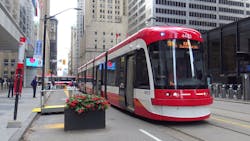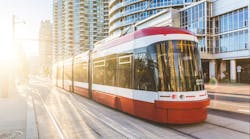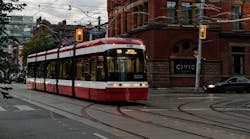The first of 60 new Toronto Transit Commission (TTC) streetcars officially entered service on Nov. 17, with an inaugural run on the 504 King route. The new streetcars are jointly funded by C$568 million (US$414 million) in contributions from the TTC’s 2023-2032 Capital Budget and Plan, government of Ontario and the city of Toronto. In May 2021, the federal and Ontario governments each announced up to C$180 million (US$131 million) toward the TTC Streetcar Program. The remaining C$208 million (US$151 million) is coming from the city of Toronto.
The TTC’s 2023-2032 Capital Budget and Plan includes the 60 low-floor streetcars and the reconfiguring of Hillcrest Complex to accommodate the storage of at least 25 streetcars. The new vehicles are being produced by Alstom at its Thunder Bay facility. The remaining streetcars will be delivered by 2025.
“The team at our manufacturing facility in Thunder Bay is unsurpassed in their experience with assembling and testing TTC streetcars, having delivered more than 200 of these vehicles through the years. We are proud to offer our customer and Torontonians the public transit they deserve through our ability to manufacture and test locally thanks to Alstom’s large industrial footprint in the province,” said David Van Der Wee, Alstom’s vice president rolling stock, North America.
In addition to streetcars, Alstom has also supplied 480 Toronto Rocket subway cars to the TTC and is currently providing a communications-based train control railway signaling solution on Line 1 Yonge–University, as well as the Toronto-York Spadina Subway Extension.
“A thriving Toronto—with reliable and sustainable public transit—is very much a part of our economic plan. Just as creating good-paying, middle-class jobs in Canada and in this city is central to our economic plan,” Deputy Prime Minister of Canada and Minister of Finance Chrystia Freeland said. “We are investing in Toronto and in Toronto’s transit infrastructure. These new made-in-Canada streetcars for the TTC are yet another example of how the people of Toronto have no greater partner than our federal government.”
“Supporting modern, safe and reliable public transit for Canadians across the country helps build more connected communities, a stronger economy and a cleaner environment,” said Sean Fraser, Canada's minister of housing, infrastructure and communities. “The arrival of these new vehicles ensures that taking a streetcar in Toronto remains comfortable, convenient and efficient.”
Since 2020, the TTC has operated only low-floor, high-capacity, fully accessible streetcars on its network. Buses also operate on the streetcar network in the short term to support ongoing construction projects in the city. The capacity of one streetcar is equal to two and a half buses.
“Streetcars are a vital part of the TTC and the city and I am pleased that we are continuing to expand our fleet and plan for ridership growth and increased demand,” said TTC Chair Jamaal Myers. “Our goal is to run a sustainable transit system that our customers can continue to rely on and be proud of. This is a big step in that direction.”
In 2022, the TTC operated nine streetcar routes, spanning approximately 355 kilometers (220 miles), carrying more than 26 million people.
“The TTC is grateful for the continued support of all orders of government as we plan for the future growth and ridership of the city,” said TTC CEO Rick Leary. “I want to thank the many TTC employees who keep Toronto moving and dedicate themselves to getting our customers to and from their destinations safely. I know how excited they will be to have more new vehicles in the fleet.”
“Transit has been a priority for me since day one. Increasing the number of streetcars on our roads means shorter wait times, more capacity and more reliable service for transit users,” said Mayor of Toronto Olivia Chow. “As Toronto continues to grow and we look for ways to improve peoples’ commutes, we need to continue to work with all levels of government to make more transit options available.”

Brandon Lewis | Associate Editor
Brandon Lewis is a recent graduate of Kent State University with a bachelor’s degree in journalism. Lewis is a former freelance editorial assistant at Vehicle Service Pros in Endeavor Business Media’s Vehicle Repair Group. Lewis brings his knowledge of web managing, copyediting and SEO practices to Mass Transit Magazine as an associate editor. He is also a co-host of the Infrastructure Technology Podcast.







